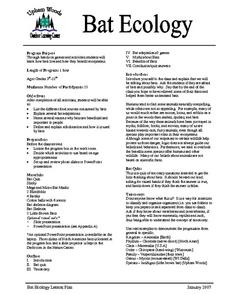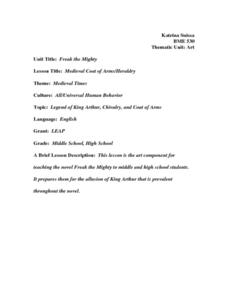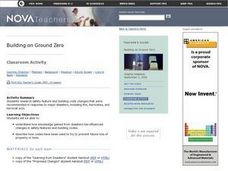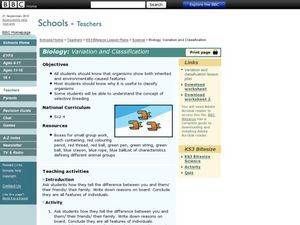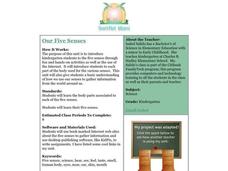Curated OER
What Role Does Light Play Within the Vision Process?
High schoolers are introduced to the relationship between light and vision. In groups, they participate in experiments to discover how different wavelengths are divided in the visible spectrum. They record their answers and discuss their...
Curated OER
Bat Ecology
Students, through hands on games and activities, discover how bats live and how bats benefit ecosystems. They play a game designed to show them how echolocation works and another to show how mother bats locate their young through their...
Curated OER
Cells All Around
Students measure the size of an epithelial cell and to estimate the number of epithelial cells in a given area of the body. After watching a video on cells, student groups perform an experiment using a microscope to view some of their...
Curated OER
Medieval Coat of Arms/Heraldry
Students examine the history of Heraldry from medieval times in preparation for reading the novel "Freak the Mighty." They view and discuss examples of shields and discuss the color system and how shields were divided. As a culminating...
Curated OER
Buzzing Bee's Wardrobe
Students investigate the anatomy of honeybees. In this anatomy instructional activity, students research the physical characteristics of bees and discover what they do. Students create a model of a honeybee showing the correct anatomy.
Curated OER
Building on Ground Zero
Learners research safety feature and building code changes that were recommended in response to major disasters, including fire, hurricanes, and terrorist acts. They understand how knowledge gained from disasters has influenced changes...
Curated OER
The Periodic Table of the Elements
Students research the elements used to create fireworks. In this periodic table lesson, students discuss common metals, their characteristics, and their places on the periodic table. They work in small groups to research the elements...
Curated OER
Beaver Ecology
Learners explore the lives of bgeahvers. They identify the physical and behavioral adaptations that help beavers survive in their environment. Students compare and contrast how beavers influence the ecology of both forest and aquatic...
Curated OER
World of Protists
Students observe a jar of pond water and predict how much life they think exists in the jar and watch a "Bill Nye: The Science Guy" video regarding protists. They participate in an online virtual pond dip where they begin to familiarize...
Curated OER
Freshwater Macroinvertebrates
Students identify and count Macroinvertebrates at a Hydrology website. In this macroinvertebrates lesson plan students collect, sort and identify Macroinvertebrates.
Curated OER
Paper Quilling: A Colonial Art
Learners discover the art of paper quilling and rolled paper. As a class, they identify patterns and forms found in nature. They create their own piece of quilled art and view their classmates creations as well.
Curated OER
Yes, Thank You!
Students explore public signage and create positive message signs. In this social interactions instructional activity, students explore their own neighborhoods for examples of positive, negative, and neutral signage and use this...
Curated OER
Hazardous Products Substitutes
Students investigate toxic substances. In this health lesson, students identify warning labels on common household cleaners and create a "less toxic" cleaning recipe book. Students recite a pledge to try a less toxic substitute at home.
Curated OER
Adaptations
Eighth graders choose an animal and research its various adaptations using
their information, 8th graders create an informational tri-fold brochure or newsletter. They should include facts about the animal's adaptations as well as...
Curated OER
Biology: Variation and Classification
Students investigate classification of different animal groups. In this biology lesson plan students list characteristics of themselves and others they know to show differences and how they are classified. Students then answer...
Curated OER
Transmission of Disease
Students provide names of viral diseases that they would possibly like to be infected with today; listing them on the Smart Board. They then come to an agreement about what virus to use and use beakers of fluids to simulate how viruses...
Curated OER
Our Five Senses
Students explore the five senses through hands-on and Internet activities.
Curated OER
Looking at Our Community
Learners analyze the way that the media views the community that they live in. They poll residents about the strengths and weaknesses of their community and devise ways such as community service projects that they can improve the image...
Curated OER
What Is It?!
Working individually or in groups, 4th graders are presented with unusual or at least unfamiliar objects and are asked to speculate on what they are and/or how they are used. The intention is to get students to make careful observations...
TED Talks
Ted: Ted Ed: The Evolution of the Human Eye
The human eye is an amazing mechanism, able to detect anywhere from a few photons to a few quadrillion, or switch focus from the screen in front of you to the distant horizon in a third of a second. How did these complex structures...
Khan Academy
Khan Academy: The Refraction of Light Through the Human Eye
This five-question quiz relating to refraction of light in the human eye.
Other
Vision Direct: The Human Eye
Explore this interactive visual to learn the parts of the eye, what the function of each is, and how they work together to give us the ability to see.
Georgia State University
Georgia State University: Hyper Physics: Scale Model of Human Eye
A scale model of the human eye is shown. Information about the parts of the eye and the common defects that result from its malfunctioning.
Other
Lens Shopper: Anatomy of the Eye
Learn about the human body's own "camera" as you explore the inner workings of the human eye. This resource is displayed as a three-dimensional, interactive animation.

